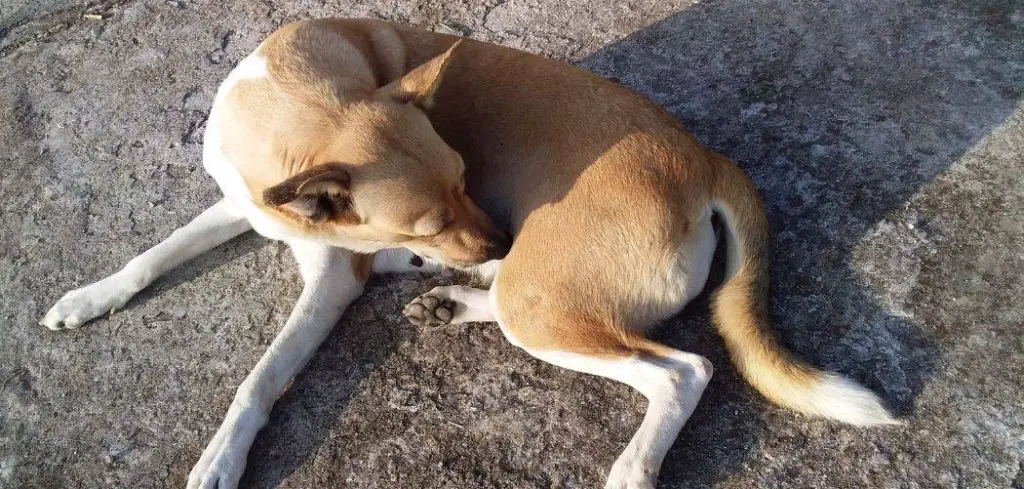A dog panting while itching excessively can be worrying for any dog owner. While panting is often a normal response to heat or exercise, when combined with persistent scratching, it may indicate underlying health issues.
We outline the common causes of panting and excessive itching in dogs, what you can do at home, and when to seek veterinary help.
Dog Panting and Itching a Lot — Why It Happens
Dog panting and itching a lot often point to allergies or skin irritation. Common triggers include fleas, pollen, food allergies, or contact irritants like shampoos or cleaning products.
The itching can cause stress and discomfort, leading to panting as your dog tries to cope or cool down.
In some cases, skin infections, hot spots, or hormonal imbalances such as Cushing’s disease may also be involved.

Dog Panting and Itching a Lot: Common Causes
Allergies
Allergies are a leading cause of itching and can also lead to panting if the dog is uncomfortable or stressed.
Dogs can develop allergic reactions to food, environmental factors like pollen, dust mites, or flea bites.
Allergies trigger itching, redness, and sometimes skin inflammation, which may make your dog pant due to discomfort and stress.
You may notice excessive scratching, licking, or biting at the skin, hair loss, redness, and sometimes watery eyes.
Persistent allergies can lead to skin infections if left untreated, making veterinary care essential.
Read more: Dog Panting and Itching At Night (Identifying underlying causes)
Flea or Parasite Infestations
Fleas, mites, and other parasites can cause intense itching and secondary stress panting.
The constant irritation leads to scratching, hair loss, and sometimes hot spots or scabs. Panting occurs when the dog becomes anxious or stressed from the discomfort.
You may spot tiny moving insects in the fur, dark flea dirt, or red inflamed areas. Severe infestations can lead to anemia or infections, so prompt treatment is necessary.
Skin Infections (Bacterial or Fungal)
Bacterial or fungal skin infections can cause localized or widespread itching and discomfort.
Infections often develop secondary to allergies, wounds, or poor grooming. Panting may appear as a response to pain or discomfort caused by the inflamed skin.
Symptoms include redness, swelling, foul odor, scabs, crusts, or oozing lesions. Veterinary diagnosis is crucial to determine the appropriate antibiotic or antifungal treatment.
Dry Skin or Environmental Irritants
Dry skin or exposure to irritants like chemicals, shampoos, or harsh weather can lead to itching and panting. Dry, flaky skin causes discomfort, prompting scratching and panting due to stress.
Signs include rough, flaky skin, localized redness, and persistent licking or scratching. Regular moisturizing shampoos and limiting exposure to irritants can help, but persistent issues need veterinary evaluation.
Heat or Stress-Related Panting
Excessive panting combined with itching can also indicate that the dog is hot or stressed.
Stress can exacerbate itching behaviors, and panting may be a physiological response to overheating or anxiety.
Look for signs like restlessness, drooling, pacing, and seeking cool surfaces. Keeping the dog hydrated and cool, along with stress-reducing strategies, can provide relief.
Food Sensitivities
Certain ingredients in a dog’s diet can cause itchiness and skin reactions. Food sensitivities may lead to mild to moderate panting if the dog is uncomfortable or agitated. Common triggers include grains, dairy, beef, or chicken in sensitive dogs.
You may notice chronic scratching, gastrointestinal upset, or localized redness. Dietary changes under veterinary guidance are often required to alleviate symptoms.
What to Do If Your Dog Is Panting and Itching a Lot
If your dog is panting and scratching excessively, start by observing closely. Note the frequency, severity, and location of the itching. Document any potential triggers like food, outdoor exposure, or grooming products.
Keep your dog calm and comfortable by providing a cool, quiet environment and limiting exposure to potential allergens or irritants. Regular grooming, bathing with hypoallergenic shampoos, and flea control can help reduce skin irritation.
Avoid giving over-the-counter medications without veterinary approval, as some human medications can be harmful to dogs. Offer fresh water frequently to prevent dehydration, especially if panting is severe.
If itching persists for more than a few days, or if there are signs of infection such as oozing, swelling, or a foul odor, consult your veterinarian promptly. Early intervention can prevent complications and improve your dog’s quality of life.
When to Call or Visit Your Vet
Seek immediate veterinary attention if your dog exhibits any of the following:
Severe or worsening panting combined with intense itching.
Open sores, bleeding, or pus on the skin.
Hair loss in large patches or signs of secondary infections.
Lethargy, vomiting, diarrhea, or other systemic symptoms.
Signs of severe stress or anxiety affecting behavior or appetite.
Prompt veterinary evaluation ensures that underlying causes, such as allergies, parasites, or infections, are treated effectively. Some conditions can progress rapidly, so timely care is essential.
Read more: Dog Panting and Itching Ear (Here’s why)
Key Takeaway
Panting and excessive itching in dogs may indicate allergies, parasites, infections, stress, or dietary sensitivities. Observing your dog, managing environmental triggers, and maintaining proper grooming are helpful first steps.
However, persistent or severe symptoms require veterinary attention to diagnose and treat the underlying cause.
Acting early ensures your dog remains comfortable, healthy, and happy. Monitoring closely and seeking professional advice when necessary is the best approach for long-term skin and overall health care.
